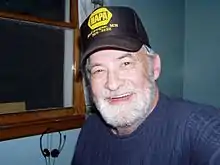Gerald W. Brown
Gerald W. "Jerry" Brown (23. February 1941 - 08. February 2019) was an American whistleblower who concerned himself with deficiencies in passive fire protection systems in US and Canadian nuclear power plants.

Thermo-Lag scandal
Brown was the original whistleblower of the Thermo-Lag 330-1 scandal,[1] which involved an endothermic material manufactured by Thermal Science Inc., also doing business as Nu-Chem, Inc. and later as TS Holdings Inc. of St. Louis, Missouri. Thermo-Lag was used to provide circuit integrity to wiring running between the nuclear reactors and the control rooms within the power stations. The purpose of the circuit designs was to ensure that in the event of a fire, the wiring remained operable so that workers could shut down reactors to prevent a nuclear meltdown.
Brown discovered and disclosed to the Nuclear Regulatory Commission (NRC) that the fire testing used to qualify Thermo-Lag was inadequate. By the time of the disclosure, many nuclear plants had already installed the faulty product. The NRC confirmed in fire testing that the installed configurations did not provide the mandated minimum level of protection; the NRC communicated this to its licensees who were subsequently required to either replace or overlay the product with one that met standards. The NRC also established a new and more stringent test procedure for qualifying circuit integrity products.
The NRC fined Thermal Science Inc. $900,000.[2] TSI rejected NRC's claims but wound up settling out of court for $300,000.[3][4]
The latest iteration of Thermo-Lag related issues involving a Thermo-Lag overlay over top of existing Thermo-Lag was USNRC Information Notice 2018-09,[5] which indicated that during the fabrication of an overlay of the existing fireproofing, on 18. March 2017, elemental carbon, from a fabric that was part of the overlay, was being cut and fabricated and as a result, debris from this fabric entered the electrical cabinet, which caused the arc flash.
The importance of firestopping of nuclear facilities was manifested in the Browns Ferry Nuclear Power Plant fire, a fire resulted from combustion of extremely flammable polyurethane foam. This led to control, communications and telemetry/data links between the control room and the reactor core being severed, causing the operators to no longer be able to exercise control over the nuclear reactor. By design, staff were able to use other controls to safely shut down the reactor.
Silicone foam
Brown also highlighted issues [6] with the use of silicone foam firestops in the United States and Canada that were not installed in accordance with appropriate certification listings. In Canada, he further pointed out inadequacies with circuit integrity not installed in accordance with appropriate certification listings, which included single-sided fire barriers for three-dimensional cable trays. The Canadian Nuclear Safety Commission does not require product certification.
Front for fire protection whistleblowers
Brown founded the Fire Protection Defense League as a front for other whistleblowers concerned with fire protection issues.[7] Through the help of Canadian members, FPDL and Brown publicised generic fire protection deficiencies in Canada concerning firestops and grease duct systems.
See also
- Nuclear and radiation accidents
- Nuclear accidents in the United States
- Nuclear safety
- Nuclear safety in the United States
References
- NRC treatise on the subject
- NRC: Thermal Science Notice of Violation
- Endothermic Products
- NRC: Thermal Science Monetary Penalties
- USNRC Information Notice 2018-09, informing USNRC licensees of the occurrence of "an electrical arc flash initiated by intrusion of foreign material into a switchgear cubicle", where elemental carbon from the fabrication of a Thermo-Lag fabric caused an explosion, which damaged an adjacent fire door.
- Flammable 'Firestops' Used in CANDU Reactors
- Fire Protection Defense League |
External links
| Wikimedia Commons has media related to Gerald W. Brown. |
- Youtube video from Gerald W Brown taking on the USNRC
- Wood Pellet Newsletter by Gerald W. Brown
- Proceedings of the Select Committee on Ontario Hydro Nuclear Affairs involving fire protection items raised by Gerald W. Brown
- Nuclear Information and Resource Service Publication about Thermo-Lag Issue, identifying Gerald W. Brown as source Nuclear Information and Resource Service
- Alternet.org treatise on nuclear fire protection issues, identifying Gerald W. Brown as the original source
- NRC document on circuit integrity and Thermo-Lag issue
- NIRS Reactorwatch
- ccnr.org Representative Ed Markey's Statements concerning flammable firestops
- Garden State EnviroNet Statement on NRC Silicone Foam Issues
- USNRC Information Notice 88-56
- WISE Netherlands Statement on FIRE PROTECTION VIOLATIONS AT U.S. NUCLEAR POWER PLANTS
- TSI/Nu-Chem/TS Holdings history
- WISE update on Thermo-Lag Scandal
- List of Nuclear Whistleblowers by Katz, Marshall & Banks, LLP, mentioning Gerald W. Brown